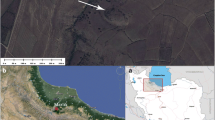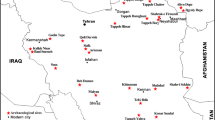Abstract
Application of bronze alloy to produce artistic and religious artefacts was commonplace during the Iron Age in western Iran (1500–550 BC). These bronze artefacts are the so-called Luristan bronzes and have been found often from excavated graves and sanctuaries. The aim of this paper is to study on alloy composition and manufacturing process in some recently excavated objects from the Iron Age cemetery of Baba Jilan, northern Luristan. For this purpose, some objects were analysed by quantitative ICP-MS as well as microscopic studies by scanning electron microscopy coupled with energy dispersive X-ray spectroscopy (SEM-EDS) and metallography methods. Also, some comparisons were carried out between Baba Jilan and other analysed bronze objects from Luristan in order to identify the metalworking process in bronze objects from the Iron Age of western Iran. The results showed that all Baba Jilan samples are made of binary copper-tin alloy. Tin content was variable in the composition of the samples. The variety of tin constituents proved that alloying has been performed by an uncontrolled process to produce bronze. The microscopic studies also showed that the manufacturing operations are similar in the Luristan bronzes. It was carried out to identify probable similarities in the bronze alloy production in the Iron Age of the Luristan region.










Similar content being viewed by others
References
Artioli G (2012) Archaeometallurgy: the contribution of mineralogy. Archaeometry and cultural heritage: the contribution of mineralogy, Seminarios de la Sociedad Española de Mineralogia 9:65–78
Bachmann HG (1982) The identification of slags from archaeological sites. In: Occasional publications 6. Institute of Archaeology, UCL, London
Begemann F, Haerinck E, Overlaet B, Schmitt-Strecker S, Tallon F (2008) An archaeo-metallurgical study of the early and middle Bronze Age in Luristan. Iran Iranica Antiqua XLIII:1–66
Coghlan HH (1975) Notes on the prehistoric metallurgy of copper and bronze in the Old World. In: Penniman TK, Blackwood BM (eds) Occasional paper on technology 4, 2nd edn. Oxford University Press, Oxford
Craddock P (2010) Early metal mining and production. Archetype Publications, London
Craddock PT, Meeks ND (1987) Iron in ancient copper. Archaeometry 29(2):187–204
Craddock P, Meeks N, Timberlake S (2007) On the edge of success: the scientific examination of the products of the Early Mines Research Group smelting experiments. In: La Niece S, Hook D, Craddock P (eds) Metals and mines: studies in archaeometallurgy. Archetype Publications, London, pp 37–45
Dungworth, D. (2013) An experimental study of some early copper smithing techniques, accidental and experimental archaeometallurgy, D. Dungworth and R.C.P. Doonan, eds., vol. HMS Occasional Publication 7, Historical Metallurgical Society, London: 149–152.
El Morr Z, Pernot M (2011) Middle Bronze Age metallurgy in the Levant: evidence from the weapons of Byblos. J Archaeol Sci 38:2613–2624
Erb-Satullo NL, Gilmour BJJ, Khakhutaishvili N (2014) Late Bronze and early Iron Age copper smelting technologies in the South Caucasus: the view from ancient Colchis c. 1500e600 BC. J Archaeol Sci 49:147–159
Erb-Satullo NL, Gilmour BJJ, Khakhutaishvili N (2015) Crucible technologies in the late Bronze–early Iron Age South Caucasus: copper processing, tin bronze production, and the possibility of local tin ores. J Archaeol Sci 61:260–276
Figueiredo E, Silva RJC, Senna-Martinez SC, Araújo MF, Fernandes FMB, Inês Vaz JL (2010) Smelting and recycling evidences from the late Bronze Age habitat site of Baiões (Viseu, Portugal). J Archaeol Sci 37:1623–1634
Fleming, S.J., Pigott, V.C., Swann, C.P., Nash, S.K. (2005). Bronze in Luristan: preliminary analytical evidence from copper/bronze artifacts excavated by the Belgian mission in Iran. Iranica Antiqua, XL, 35–64
Fleming SJ, Pigott VC, Swann CP, Nash SK, Haerinck E, Overlaet B (2006) The archaeometallurgy of War Kabud. Western Iran Iranica Antiqua XLI:31–57
Frame L (2010) Metallurgical investigations at Godin Tepe, Iran, part I: the metal finds. J Archaeol Sci 37:1700–1715
Hasanpur A, Hashemi Z, Overlaet B. (2015) The Baba Jilan graveyard near Nurabad, Pish-i Kuh Luristan—a preliminary report. Iran Antiqua L:171–212.
Hauptmann A (2007) The archaeometallurgy of copper: evidence from Faynan. Jordan, Springer Science & Business Media
Hauptmann A (2014) The investigation of archaeometallurgical slag. In: Roberts BW, Thornton CP (eds) Archaeometallurgy in global perspective, methods and syntheses. Springer, New York, pp 91–105
Helwing B (2009) Rethinking the tin mountains: patterns of usage and circulation of tin in greater Iran from the 4th to the 1st millennium BC. TUBA-AR 12:209–221
Henderson J (2000) The science and archaeology of materials: an investigation of inorganic materials. Routledge, Abingdon
Joannes F (1997) Metalle und Metallurgie, A. I. in Mesopotamien. Reallexikon der Assyriologie und vorderasiatischen Archäologie 8:96–112
Meeks N (1993a) Patination phenomenon on Roman and Chinese high-tin bronze mirrors and other artefacts. In: La Niece S, Craddock P (eds) Metal plating and patination, cultural, technical and historical developments. Butterworth-Heinemann, Oxford, pp 63–84
Meeks N (1993b) Surface characterization of tinned bronze, high-tin bronze, tinned iron and arsenical bronze. In: La Niece S, Craddock P (eds) Metal plating and patination, cultural, technical and historical developments. Butterworth-Heinemann, Oxford, pp 247–275
Mödlinger M, El Morr Z (2014) European Bronze Age sheet metal objects: 3000 years of high-level bronze manufacture. JOM 66:171–177
Mödlinger M, Piccardo P (2013) Manufacture of Eastern European decorative tin–bronze discs from twelfth century BC. Archaeol Anthropol Sci 5:299–309
Momenzadeh M (2004) Metallic mineral resources of Iran, mined in ancient times: a brief review. In: Stöllner T, Slotta R, Vatandoust A (eds) Persia’s ancient splendour, mining, handicraft and archaeology. Deutsches Bergbau-Museum, Bochum, pp 8–21
Moorey PRS (1964) An interim report on some analyses of “Luristan bronzes”. Archaeometry 7:72–79
Moorey PRS (1969) Prehistoric copper and bronze metallurgy in western Iran (with special reference to Lūristān). Iran 7:131–153
Moorey PRS (1971) Towards a chronology for the Lūristān bronzes. Iran 9:113–129
Moorey PRS (1974) Ancient Persian bronzes in the Adam collection. Faber and Faber, London
Moorey PRS (1994) Ancient Mesopotamian materials and industries: the archaeological evidence. Oxford University Press, Oxford
Mortazavi M, Salehi Kakhki A, Golozar MA, Talái H (2011) Preliminary metallurgical investigation of copper-based artifacts at Tepe Sagzabad in Qazvin Plain, Iran (1500–800 BC). Iranian J Archaeol Stud 1:49–59
Muscarella OW (1988) Bronze and iron: ancient near eastern artifacts in the Metropolitan Museum of Art. The Metropolitan Museum of Arts, New York
Nezafati N (2006) Au-Sn-W-Cu-mineralization in the Astaneh-Sarband area, west central Iran, including a comparison of the ores with ancient bronze artifacts from western Asia. Der Geowissenschaftlichen Fakultät, Der Eberhard-Karls-Universität Tübingen, Germany, PhD Dissertation
Oudbashi O, Davami P (2014) Metallography and microstructure interpretation of some archaeological tin bronze vessels from Iran. Mater Charact 97:74–82
Oudbashi O, Hasanpour A (2016) Microscopic study on some Iron Age bronze objects from western Iran. Heritage Science 4:8
Oudbashi O, Hessari M (2015) Iron Age tin bronze metallurgy at Marlik, northern Iran: an analytical investigation. Archaeol Anthropol Sci 2015. doi:10.1007/s12520-015-0280-1
Oudbashi O, Emami SM, Malekzadeh M, Hassanpour A, Davami P (2013) Archaeometallurgical studies on the bronze vessels from "Sangtarashan". Luristan, W-Iran Iranica Antiqua XLVIII:147–174
Oudbashi O, Naseri R, Malekzadeh M (2016) Technical studies on the bronze age metal artefacts from the graveyard of Deh Dumen, south-western Iran (third millennium BC). Archaeometry 58:947–965
Overlaet B (2004) (2004) Luristan metalwork in the Iron Age. In: Stöllner T, Slotta R, Vatandoust A (eds) Persiens Antike Pracht. Bergbau Handwerk Archäologie, Exhibition Catalogue, Deutsches Bergbau-Museum, Bochum, pp 328–338
Pigott VC (1990) Bronze. In: Iran P-I, Yarshater IE (eds) Encyclopedia Iranica, Vol. IV, Fasc. 5. Routledge & Kegan Paul, London and New York, pp 457–471
Pigott VC (1999) The development of metal production in Iranian Plateau: an archaeometallurgical perspective. In: Pigott VC (ed) The archaeometallurgy of Asian Old World, University Museum Monograph 89. University of Pennsylvania Museum, Philadelphia, pp 73–106
Pigott VC (2004) On the importance of Iran in the study of prehistoric Copper-Base metallurgy. In: Stöllner T, Slotta R, Vatandoust A (eds) Persia’s ancient splendour, mining, handicraft and archaeology. Deutsches Bergbau-Museum, Bochum, pp 24–43
Potts DT (1997) Mesopotamian civilization: the material foundations. Cornell University Press, New York
Pulak C (2000) The copper and tin ingots from the late Bronze Age shipwreck at Uluburun. In: Yalçin Ü (ed) Anatolian metal I, Der Anschnitt13. Deutsches Bergbau-Museum, Bochum, pp 137–157
Rehren T, Pernicka E (2008) Coins, artefacts and isotopes-archaeometallurgy and archaeometry. Archaeometry 50:232–248
Roberts BW, Thornton CP (eds) (2014) Archaeometallurgy in global perspective. Springer Science and Business Media, New York
Rostoker W, Pigott VC, Dvorak JR (1989) Direct reduction to copper metal by oxide-sulfide metal interaction. Archeomaterials 3:69–87
Scott DA (1991) Metallography and microstructure of ancient and historic metals. Getty Conservation Institute, Los Angeles
Scott DA (2010) Ancient metals: microstructure and metallurgy, vol 1. Conservation Science Press, Los Angeles, Principles and Practice
Thornton CP (2009) The emergence of complex metallurgy on the Iranian Plateau: escaping the Levantine Paradigm. Journal of World Prehistory 22:301–327
Valério P, Silva RJC, Monge Soares AM, Araújo MF, Fernandes FMB, Silva AC, Berrocal-Rangel L (2010) Technological continuity in early Iron Age bronze metallurgy at the south-western Iberian Peninsula—a sight from Castro dos Ratinhos. J Archaeol Sci 37:1811–1819
Valério P, Silva RJC, Araújo MF, Monge Soares AM, Barros L (2012) A multianalytical approach to study the Phoenician bronze technology in the Iberian Peninsula—a view from Quinta do Almaraz. Mater Charact 67:74–82
Valério P, Monge Soares AM, Silva RJC, Araújo MF, Rebelo P, Neto N, Santos R, Fontes T (2013) Bronze production in southwestern Iberian Peninsula: the late Bronze Age metallurgical workshop from Entre Águas 5 (Portugal). J Archaeol Sci 40:439–451
Van Brempt L, Kassianidou V (2016) Facing the complexity of copper-sulphide ore smelting and assessing the role of copper in south-central Cyprus: a comparative study of the slag assemblage from late Bronze Age Kalavasos-Ayios Dhimitrios. J Archaeol Sci: Reports 7:539–553
Vatandoust-Haghighi A (1999) A view on prehistoric Iranian metalworking: elemental analyses and metallographic examinations. In: Hauptmann A, Pernicka E, Rehren T, Yalçin Ü (eds) The beginnings of metallurgy, proceedings of international conference in Bochum 1995, Der Anschnitt, Beiheft 9 , pp 121–140Bochum
Acknowledgements
The authors are thankful to Dr. Mohammadreza Kargar (GOMCHTO, ICHTO), Ali Hojabri (ICHTO of Zanjan Province) and Rouhoddin Pourzarrin (ICHTO of Lorestan Province) for the permission to access the samples, Behnam Rahmani, Nazanin Nikroo (Razi Applied Science Foundation) and Atefeh Shekofteh (Art University of Isfahan) for their valuable help and comments in archaeological and experimental studies and text editing. The experimental and technical works presented in this paper have been carried out in the framework of the research project rent No. 939/10, financed by the Research Office of Art University of Isfahan, Iran in 2015–2016.
Author information
Authors and Affiliations
Corresponding author
Rights and permissions
About this article
Cite this article
Oudbashi, O., Hasanpour, A. Bronze alloy production during the Iron Age of Luristan: a multianalytical study on recently discovered bronze objects. Archaeol Anthropol Sci 10, 1443–1458 (2018). https://doi.org/10.1007/s12520-017-0466-9
Received:
Accepted:
Published:
Issue Date:
DOI: https://doi.org/10.1007/s12520-017-0466-9




